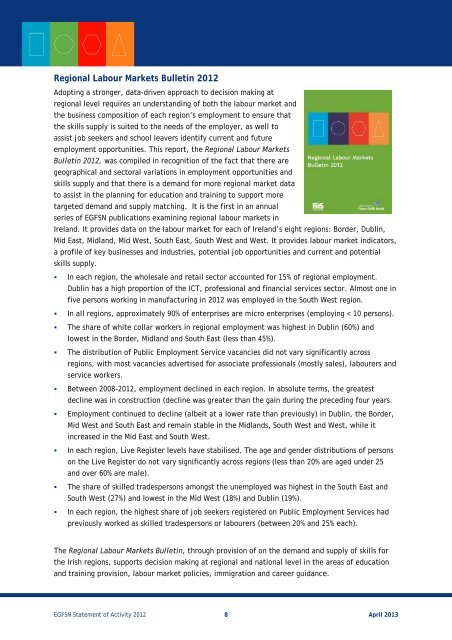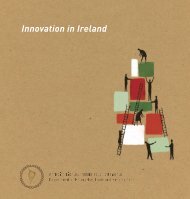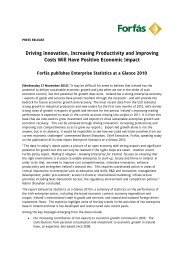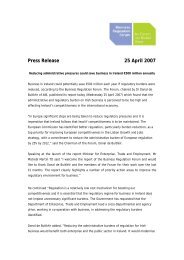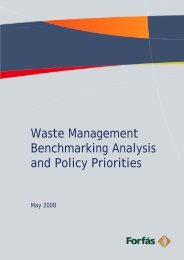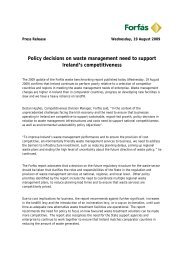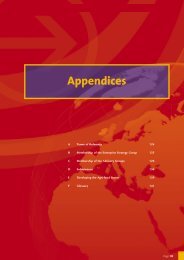EGFSN Statement of Activity (PDF, 29 pages , 416KB) - Skills Ireland
EGFSN Statement of Activity (PDF, 29 pages , 416KB) - Skills Ireland
EGFSN Statement of Activity (PDF, 29 pages , 416KB) - Skills Ireland
Create successful ePaper yourself
Turn your PDF publications into a flip-book with our unique Google optimized e-Paper software.
Regional Labour Markets Bulletin 2012<br />
Adopting a stronger, data-driven approach to decision making at<br />
regional level requires an understanding <strong>of</strong> both the labour market and<br />
the business composition <strong>of</strong> each region’s employment to ensure that<br />
the skills supply is suited to the needs <strong>of</strong> the employer, as well to<br />
assist job seekers and school leavers identify current and future<br />
employment opportunities. This report, the Regional Labour Markets<br />
Bulletin 2012, was compiled in recognition <strong>of</strong> the fact that there are<br />
geographical and sectoral variations in employment opportunities and<br />
skills supply and that there is a demand for more regional market data<br />
to assist in the planning for education and training to support more<br />
targeted demand and supply matching. It is the first in an annual<br />
series <strong>of</strong> <strong>EGFSN</strong> publications examining regional labour markets in<br />
<strong>Ireland</strong>. It provides data on the labour market for each <strong>of</strong> <strong>Ireland</strong>’s eight regions: Border, Dublin,<br />
Mid East, Midland, Mid West, South East, South West and West. It provides labour market indicators,<br />
a pr<strong>of</strong>ile <strong>of</strong> key businesses and industries, potential job opportunities and current and potential<br />
skills supply.<br />
In each region, the wholesale and retail sector accounted for 15% <strong>of</strong> regional employment.<br />
Dublin has a high proportion <strong>of</strong> the ICT, pr<strong>of</strong>essional and financial services sector. Almost one in<br />
five persons working in manufacturing in 2012 was employed in the South West region.<br />
In all regions, approximately 90% <strong>of</strong> enterprises are micro enterprises (employing < 10 persons).<br />
The share <strong>of</strong> white collar workers in regional employment was highest in Dublin (60%) and<br />
lowest in the Border, Midland and South East (less than 45%).<br />
The distribution <strong>of</strong> Public Employment Service vacancies did not vary significantly across<br />
regions, with most vacancies advertised for associate pr<strong>of</strong>essionals (mostly sales), labourers and<br />
service workers.<br />
Between 2008-2012, employment declined in each region. In absolute terms, the greatest<br />
decline was in construction (decline was greater than the gain during the preceding four years.<br />
Employment continued to decline (albeit at a lower rate than previously) in Dublin, the Border,<br />
Mid West and South East and remain stable in the Midlands, South West and West, while it<br />
increased in the Mid East and South West.<br />
In each region, Live Register levels have stabilised. The age and gender distributions <strong>of</strong> persons<br />
on the Live Register do not vary significantly across regions (less than 20% are aged under 25<br />
and over 60% are male).<br />
The share <strong>of</strong> skilled tradespersons amongst the unemployed was highest in the South East and<br />
South West (27%) and lowest in the Mid West (18%) and Dublin (19%).<br />
In each region, the highest share <strong>of</strong> job seekers registered on Public Employment Services had<br />
previously worked as skilled tradespersons or labourers (between 20% and 25% each).<br />
The Regional Labour Markets Bulletin, through provision <strong>of</strong> on the demand and supply <strong>of</strong> skills for<br />
the Irish regions, supports decision making at regional and national level in the areas <strong>of</strong> education<br />
and training provision, labour market policies, immigration and career guidance.<br />
<strong>EGFSN</strong> <strong>Statement</strong> <strong>of</strong> <strong>Activity</strong> 2012 8 April 2013


